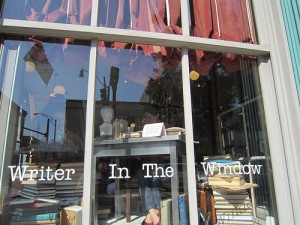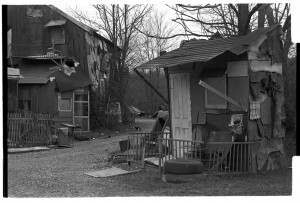
Taxi libres happen now in Mexico and central and south America, but were part of Santa Fe's scene in the 1980s, remembers Cissie Ludlow. Photo: Google images
Santa Fe Minus Thirty Years: An Interview with Cissie Ludlow
“It’s very hard to tell the difference between the set of Desperate Living and the De Vargas Hotel.”
That’s Cissie Ludlow describing the hotel and movie-set subjects she shot thirty years ago in Santa Fe and in Baltimore. She moved to Santa Fe in 1972 while traveling the country in a school bus, and began studying photography in 1976 at the Center for the Eye, located in the basement of the Armory for the Arts. She had received a B.F.A. in painting from Maryland Institute College of Art, where she met filmmaker John Waters whose movie sets, including Desperate Living and Hairspray, she has also photographed. Nancy Sutor co-curated At Last, a show of Ludlow’s 1970-’80s era work, with Brandee Caoba. It will open June 16th for four days at PHIL Space Santa Fe, 1410 Second Street. (See the virtual exhibition here.)
What was Santa Fe like in 1984?

Cissie Ludlow: “Santa Fe City Streets” was going on. It was sponsoring a lot of street art. Georgelle Hirliman was sitting in the window of the Gamut, answering questions for passers-by as she tried to break her writer’s block. That was the beginning of Writer in the Window. Taxi Libre was going on.
Nancy Sutor: It was an era when there was some funding from the NEA. Suzanne Jamison (had co-founded Santa Fe Council for the Arts.) There were lots of communal projects and community projects. Trashique was a cross-over between art and fashion and ecology and early recycling. There was the Fakery Bakery. The two guys made pastries that for all the world looked good enough to eat, out of cardboard boxes and bubble wrap and spray paint. I had one for years and years and years and then it disintegrated.
Cissie: I don’t think the artists took themselves so seriously in those days. Everyone would just jump in and do stuff. And in the ‘80s Santa Fe was and had been a mecca for photographers anyway. Beaumont Newhall was still living. Eliot Porter was alive. Paul Caponigro was alive. Santa Fe Center for Photography started in the ’70s. That was a group some of us started. That’s how I met Nancy.
Nancy: It was cheaper to live here then. Blond Sin happened in my backyard. I don’t know how many peoples’ heads I dyed blond.
In 1982 the Madonna show was on the theme of the Madonna. Doris Cross participated. Harvey Mudd read his poetry. Blue McRight had a Lady of Guadalupe cut-out where you put your head in and had your picture taken. The Catholic Church went a little bonkers on it and wanted to shut it down. Shelley Horton-Trippe was a Madonna holding her child (Bess Murphy, who was newborn in 1982) in Raul’s storefront.
Who were some of the characters you encountered at the DeVargas Hotel?
Cissie: By the time I started photographing in 1984 they had already announced they were going to close the hotel so they were slowly removing the residents from the hotel. It’s really important that people understand it was a residential hotel. When Santa Fe lost that it gained a lot of homeless people. I met Bob Brady there, who worked at the front desk. Laura Chancellor was an artist living in residence there. Georgelle Hirliman was living in residence there. It was basically empty so I had free rein to go around to all the rooms and photograph.
The De Vargas had been the political center back in the heyday. The legislators from the Capitol would all go over there, meet there, stay there, go to the bar there. The bus station was half a block from the hotel. Where the Coyote Cafe is is where the bus station was. That’s a good example of what happened downtown.
When I photographed the De Vargas Hotel it was shabby — not chic shabby, just dirty shabby.
Why haven’t you shown these photographs before?
Cissie: You never got paid. You scrapped around for grants. If you didn’t get them you didn’t make prints. I didn’t have the money to print so all of this (material) has been sitting in negative sheets. (In 1992, Ludlow earned a master’s degree in social work from New Mexico Highlands University and spent almost 20 years providing case management and parenting education for teen mothers attending Santa Fe High School.)

Cissie Ludlow,
Shantytown,
Movie Set series,
1976
How did you come to be on the set of the John Waters movie, Desperate Living in 1976?
I was in Baltimore visiting Vincent Peranio. We had met at the first day at Maryland Institute College of Art and had been a couple. That was in ’67. Susan Lowe introduced us all to John (Waters). He was about to make Multiple Maniacs. In ‘76 I went to Baltimore to see Vincent. They were filming Desperate Living. They were the first serious photographs I had started taking anywhere. John asked me not to ever sell them and I agreed. I asked him this time if I could print them for the show and he was like, ‘yeah, do whatever you want.”
The exhibit opens from 5-8 p.m. on June 16th, which is Cissie Ludlow’s 70th birthday, at PHIL Space Santa Fe, 1410 Second Street, and stays open through June 20th.
